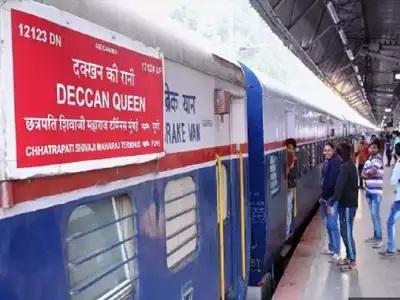
PIB News Update: One of the most prestigious trains with rich heritage value of Indian Railways namely the Deccan Queen Express (Train No. 12123/12124) running between Mumbai and Pune in Maharashtra is gearing up for a major revamp. Firstly, the 90-year old train is now proposed to be upgraded with the German design Linke Hofmann Busch (LHB) coaches. LHB coaches have a better safety features and improved travelling experience – better suspension system and better riding comfort. Secondly, there is proposed revamp of external livery design of the train which will be used in the proposed LHB rake of the train. Presently, Deccan Queen has a unique existing livery colour of blue and white with a red band. Thirdly, there is also a proposal for a New Logo of the proposed LHB upgrade of the train.
Central Railway which operates this train has started this exercise of revamping external livery design of this proposed LHB upgrade of DQ. In light of deep emotional connect of rail commuters with this train, the Central Railway has sought customer opinion on the preferred external livery design. Based on various consultation and customer feedback, the Central Railway has prepared eight different livery design along with their ranking as per the customer voting. A new logo design has also been proposed incorporating an image of the UNESCO listed Mumbai-CSMT station. On the advice of the Railway Board, the Central Railway has engaged National Institute of Design (NID), Ahmedabad, an autonomous Institution under the Ministry of Commerce & Industry, Government of India to provide their professional inputs on the livery designs. Central Railway has made all the eight different livery designs, logo design and other related material available to NID.
Accordingly, the NID team has visited Mumbai to inspect the existing train and travelled in DQ and interacted with the customers to gain the first-hand experience. They also visited the UNESCO certified CSMT building. During their visit, the team is doing data collection, measurements, photography, filming, interaction with the railway officials and passengers. They are expected to submit their report sometime later this month. This exercise is an excellent example of synergy between two Ministries of Government of India namely Ministry of Railways and Ministry of Commerce & Industry.
This train is well-patronised service since 1930. It also has many records like India’s first superfast train, first long distance electric hauled train, first vestibuled train, first train to have ladies’ only car, first train to feature a dining car.
Background
The introduction of “Deccan Queen’’ between the two premier cities of Maharashtra on 1st June 1930 was a major landmark in the history of the Great Indian Peninsula Railway, the forerunner of the Central Railway. This was the first deluxe train introduced on the railway to serve 2 important cities of the region and was aptly named after Pune, which is also known as “Queen of Deccan’’ (“Dakkhan ki Rani’’).
Initially, the train was introduced with 2 rakes of 7 coaches each one of which was painted in silver with scarlet mouldings and the other with royal blue with gold lines. The under frames of the coaches of the original rakes were built in England while the coach bodies were built in the Matunga Workshop of the GIP Railway.
The coaches of the original rakes were replaced in 1966 by anti-telescopic steel bodied integral coaches built by Integral Coach Factory, Perambur. These coaches incorporated improved design of bogies for better riding comfort and also improvements in the interior furnishings and fittings. The number of coaches in the rake was also increased to 12 from the original 7 coaches providing additional accommodation. Over the year the number of coaches in the train has been increased to the present level of 17 coaches.
With the ever-growing aspirations of the travelling public for better amenities, improved standards of comfort and better quality of service, it was considered necessary to give a complete facelift to the Deccan Queen.
The rake was changed in 1995 with the following special features:
- All newly manufactured or about a year old, air brake coaches.
- The 5 first class chair car in the old rake have been replaced by 5 AC chair cars providing an additional seating capacity of 65 in a dust-free environment. Also the 9-second class chair cars provide additional seating capacity of 120 seats compared to the old coaches.
- The dining car offers table service for 32 passengers and has modern pantry facilities such as microwave oven, deep freezer and toaster. The dining car is also tastefully furnished with cushioned chairs and carpet.
The history of Deccan Queen (Dakkhan ki Rani) is literally a tale of two cities. The public of both the cities are happy with the impeccable record of “right time start” and “arrival” of Deccan Queen. Over the last 89 years of its colorful history, the train has grown from a mere medium of transportation between two cities into an institution binding generation of intensely loyal passengers. Presently, Deccan Queen (12123/12124) runs with 17 coaches including 4 AC chair car, one Buffet Car, 10 second class chair car and two second class cum brake vans.
National Institute of Design (NID), established in 1961 as an autonomous Institution under the Ministry of Commerce & Industry, is one of the foremost multidisciplinary Institutions in the field of design education, applied research, training, design consultancy services, and outreach programmes.







Leave a Reply
You must be logged in to post a comment.